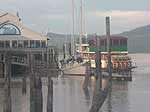 |
Published 08/20/09
It's All About Beachcombing for Plastics on the Oregon Coast
 |
| Oceanographer Curtis Ebbesmeyer will talk on August 26 in Astoria. |
(Astoria, Oregon) - Beachcombing for science, and the very serious issue of marine debris, will be the topics when the CoastWatch program brings oceanographer Curtis Ebbesmeyer to Astoria on Wednesday, August 26 for a free public slide talk.
Ebbesmeyer, famous for tracing ocean currents by means of tracking Nike sneakers and rubber duckies, will discuss his new book "Flotsametrics," and what he has learned about flotsam, jetsam and the impact of plastics on the ocean. His presentation takes place 7 p.m. at the First Presbyterian Church, 1101 Grand Ave. in Astoria.
CoastWatch, a program of the Oregon Shores Conservation Coalition, engages volunteers in monitoring mile-long segments of the Oregon shoreline. Ebbesmeyer's lecture is part of CoastWatch's ongoing training efforts for its volunteers. However, his information is of interest to all beachcombers and everyone concerned about the environmental health of the sea, and the event is open to all.
 |
| Ebbesmeyer's latest book. |
Ebbesmeyer makes ocean science fun, and his talk will convey much that he has learned about how the oceans behave and the pleasures of his quirky form of research. But there is a dark side to the flotsam Ebbesmeyer and the beachcombers who collaborate with him have been observing. In the course of his studies, he has become painfully aware of the prevalence of marine debris and its impact, and his talk will deal with the plastics and other materials that are altering the marine environment while circling the globe.
Dr. Curtis Ebbesmeyer, whose doctorate is from the University of Washington, spent a full career as a consulting oceanographer, studying such things as sewage plant outfall effluent. However, the great Nike sneaker spill of 1990 - in which beachcombers found thousands of well-preserved sneakers and set up networks to seek matches - inspired him with the idea of using flotsam to trace ocean currents. Product spills take place at known times and locations, so tracking such items when they wash up on shore can provide valuable insight into the pattern and speed of currents.
 Ebbesmeyer organized Beachcombers’ and Oceanographers’ International Association, to put beachcombers in touch with scientists who can use information about their findings, and in 1996 began publishing Beachcombers’ Alert. Since that time, he and his network of cooperating shore-walkers have tracked everything from Legos to hockey gloves to the aforementioned “rubber duckies” (which, like most of the debris circulating in the oceans, are actually made of plastic). His work has been widely covered in the media. His new book, written with Eric Scigliano, chronicles his adventures in the world of floating debris and what "flotsametrics" has taught him about the state of the ocean (see www.flotsametrics.com).
Ebbesmeyer organized Beachcombers’ and Oceanographers’ International Association, to put beachcombers in touch with scientists who can use information about their findings, and in 1996 began publishing Beachcombers’ Alert. Since that time, he and his network of cooperating shore-walkers have tracked everything from Legos to hockey gloves to the aforementioned “rubber duckies” (which, like most of the debris circulating in the oceans, are actually made of plastic). His work has been widely covered in the media. His new book, written with Eric Scigliano, chronicles his adventures in the world of floating debris and what "flotsametrics" has taught him about the state of the ocean (see www.flotsametrics.com).
CoastWatch volunteers monitor and pick up marine debris on their adopted segments of shoreline. New volunteers are needed to fill a number of gaps in coverage on the north coast.
For more information about the event or about CoastWatch, contact Phillip Johnson, CoastWatch Director, at (503) 238-4450, orshores@teleport.com
 |
 |
 |
 |
RELATED STORIES
Unusual Travel Articles TravelParanormal.com allows you to submit your own creepy tale or debunk one - or see up-to-the-minute news headlines about travel and the paranormal.
Watching Transformations of Oregon Coast Beaches Seasons change and so do beaches, revealing different sides and a variety of eye-popping sights
Staggeringly Cool Ideas for Oregon Coast Romance Be it the season of Valentine's or be it any time of the year, Oregon's coastline has essentially cornered the market for cuddle-inducing possibilities and gushy activities for the hand-holding set
Day or Night Mysteries and Merriment on Oregon Coast It's more than just nightlife that comes to life, but the beaches offer major opportunities
News Headlines from All Over Oregon Need to scan Oregon headlines? Constantly updated news from all over Oregon: a comprehensive, up-to-the-minute display of news headlines from a variety of media.
Secrets of the Season |



































